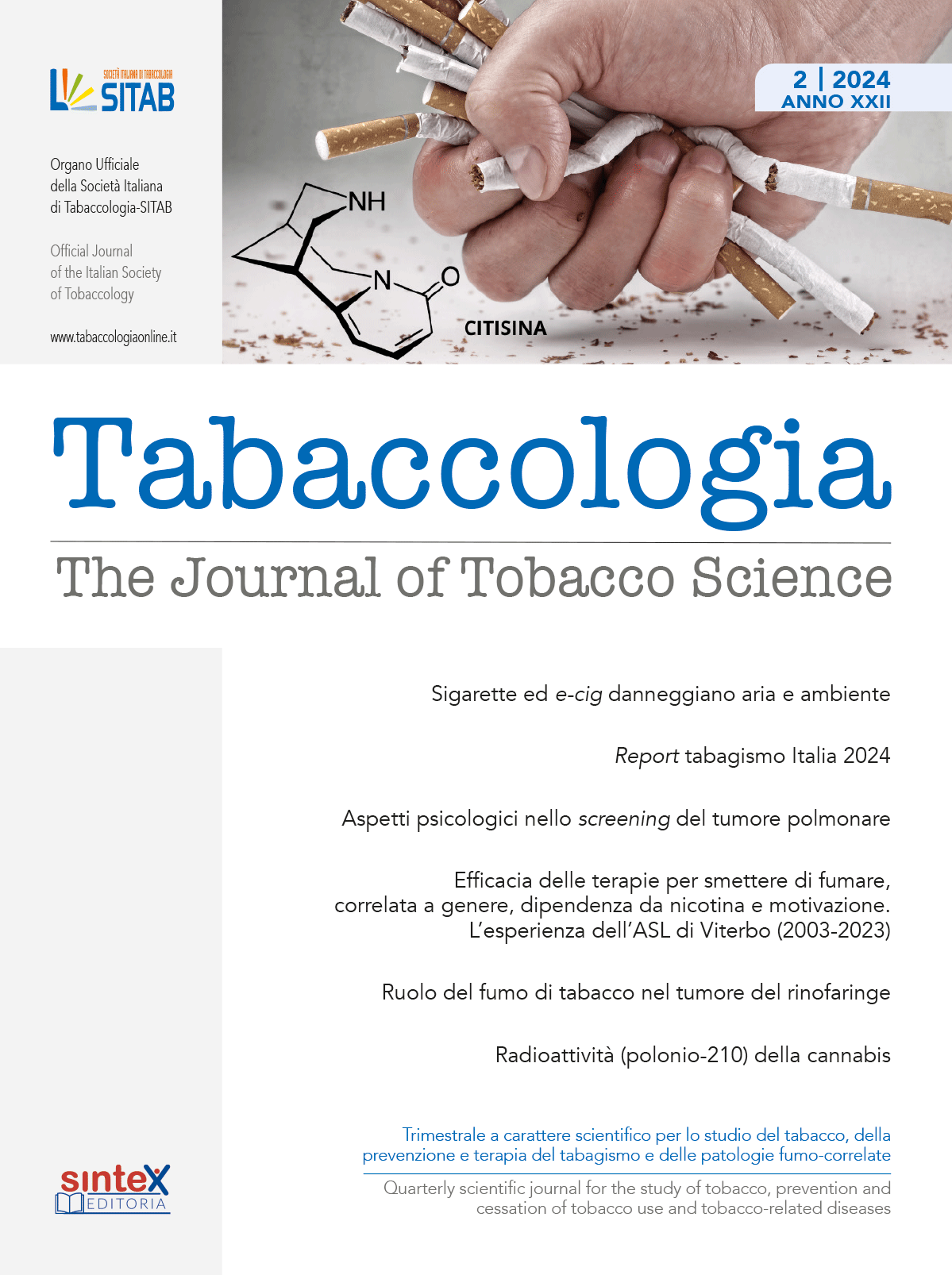|
Rassegna Stampa Scientifica Ottobre 2021
Prenatal Tobacco Exposure and the Risk of Tobacco Smoking and Dependence in Offspring: a Systematic Review and Meta-Analysis Drug Alcohol Depend. 2021 Aug 27;227:108993. Online ahead of print. Bereket Duko, Gavin Pereira, Robert J Tait, Sylvester Dodzi Nyadanu, Kim Betts, Rosa Alati https://www.sciencedirect.com/science/article/abs/pii/S0376871621004889
"The web of this chronic disease, whether it be defined as tobacco use disorder or nicotine dependence, intermingles itself among almost every other disease state, both acute and chronic. It is one of the single most important diagnoses because successful treatment leads to less of a need for treatment of other illnesses such as stroke, peripheral artery disease, coronary disease, and many more. However, we continue to put these and other diagnoses above tobacco use disorder on the problem list, and despite the best efforts of select policy makers and electronic medical record designers, it is subsequently overlooked, ignored, and improperly managed."
Letter to the Editor Changing the Culture of Tobacco Dependence Treatment Among Not Only Patients, But Also Prescribers Mayo Clin Proc. 2021 Sep;96(9):2494-2495. Adam Edward Lang https://www.mayoclinicproceedings.org/article/S0025-6196(21)00550-4/fulltext
Authors' Reply:
In Reply: Changing the Culture of Tobacco Dependence Treatment Among Not Only Patients, But Also Prescribers https://www.mayoclinicproceedings.org/article/S0025-6196(21)00556-5/fulltext Note: Open Access.
"We conducted a random effects meta-analysis and examined heterogeneity across 27 studies through subgroup analyses and meta-regression. Tobacco retailer density (RRR=2.55, 95% CI 1.91 to 3.19, k=155) and proximity (RRR=2.38, 95% CI 1.39 to 3.37, k=100) were associated with tobacco use behaviours. Pooled results including both density and proximity found an estimated 2.48% reduction in risk of tobacco use from reductions in tobacco retailer density and proximity (RRR=2.48, 95% CI 1.95 to 3.02, k=255)… Conclusions: Across studies, lower levels of tobacco retailer density and decreased proximity are associated with lower tobacco use. Reducing tobacco supply by limiting retailer density and proximity may lead to reductions in tobacco use."
Associations of tobacco retailer density and proximity with adult tobacco use behaviours and health outcomes: a meta-analysis Tobacco Control Published Online First: 03 September 2021. Joseph G L Lee, Amanda Y Kong, Kerry B Sewell, Shelley D Golden, Todd B Combs, Kurt M Ribisl, Lisa Henriksen https://tobaccocontrol.bmj.com/content/early/2021/09/03/tobaccocontrol-2021-056717
Also:
Call for emergency action to limit global temperature increases, restore biodiversity and protect health https://tobaccocontrol.bmj.com/content/early/2021/09/02/tobaccocontrol-2021-056997 Note: Open Access.
"An increase in the percent of a county's population covered by smoke-free air laws yielded a significant decline of 2.4% (RR: 0.976, 95%CI: 0.954, 0.997) in acute cerebrovascular disease hospitalizations among older adults. Moreover, significant declines of 2.0% (RR: 0.980, 95%CI: 0.967, 0.994) and 2.8% (RR: 0.972, 95%CI:0.949, 0.996) in acute cerebrovascular disease were observed among older adults in the first year and subsequent years after smoke-free air legislation was implemented, respectively. Conventional cigarette taxes did not yield a significant change in acute cerebrovascular disease hospitalizations, nor did either tobacco control policy lead to a significant decline in acute myocardial infarction hospitalizations."
The impact of smoke-free air laws and conventional cigarette taxes on cardiovascular hospitalizations Nicotine Tob Res. 2021 Sep 4;ntab158. Online ahead of print. Jon F Oliver https://academic.oup.com/ntr/advance-article-abstract/doi/10.1093/ntr/ntab158/6364115
Analysis of Wholesale Cigarette Sales in Canada After Menthol Cigarette Bans JAMA Netw Open. 2021;4(11):e2133673. November 9, 2021 Michael Chaiton, Robert Schwartz, Anasua Kundu, Christopher Houston, Robert Nugent https://jamanetwork.com/journals/jamanetworkopen/fullarticle/2785881
Note: Open Access.
Related coverage:
Study: Ban on menthol cigarettes in Canada had more people quit smoking In Canada, Ban on Menthol Cigarettes Had More Smokers Quitting
"A total of 1466 respondents (52.8%) — including 145 of 457 current smokers (31.7%), 367 of 682 adults under 30 years of age (53.8%), and 599 of 1122 adults aged 50 or more (53.4%) — thought it would be good were selling cigarettes in retail outlets phased out; 533 (19.2%), including 181 smokers (39.6%), thought it would be bad. A total of 1779 respondents (64.2%) thought it fair to implement the phase‐out within the next ten years… Support for phasing out sales and for doing so within five years was greatest among never smokers and lowest among smokers; age group did not influence support for phasing out sales, but affirming that doing so within five years was fair was higher among respondents aged 30 years or more."
Public support for phasing out the sale of cigarettes in Australia Med J Aust 2021; 215 (10): 471-472. Published online: 30 August 2021 Emily Brennan, Sarah Durkin, Michelle M Scollo, Maurice Swanson and Melanie Wakefield https://www.mja.com.au/journal/2021/215/10/public-support-phasing-out-sale-cigarettes-australia
Related MJA Perspective & coverage:
It is time for governments to support retailers in the transition to a smoke‐free society Australian governments urged to set a date to ban cigarette retail sales
"Wanting and planning to quit were significantly positively associated with making quit attempts, but negatively associated with smoking abstinence. A significant interaction between the Heaviness of Smoking Index and age warranted an age-stratified analysis for both abstinence outcomes. Lower HSI predicted abstinence in only the younger smokers. Motivation and plans to quit were positively associated with abstinence in younger smokers, but surprisingly were negatively associated with abstinence in older smokers."
|





















